|
|
|
Road Test 2 |
|
I
did not have the opportunity to try out the speed related intermittent
windscreen wipers - perversely the sun shone throughout the four days
of the test but I have no reason to believe they will be anything less
than impressive. Headlights were excellent on both dipped and main beam.
So
far, so good. However, no car is perfect and it must be said that the
Picasso falls short of perfection on a number of scores:- firstly there
is the digital speedo on which I have already commented.
|
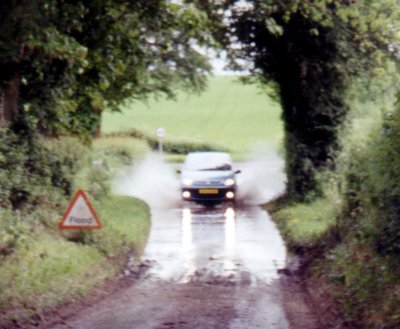
|
|
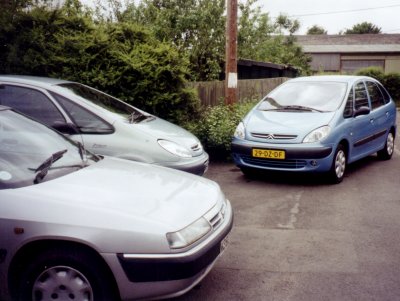
|
Secondly,
the bodywork contains a lot of visible spot welds - visible when the
doors and bonnet are opened - and evidence of lead filler. Shutlines
could be better too. Although the paintwork is excellent on the
exterior, it was patchy on panels that are normally hidden from view.
The Dutch car was worse than the British one in this respect - lacquer
had not been applied to the transverse under bonnet panel. The bonnet
panel itself is crudely made. Looking at the underside of the car,
there are a number of mud traps.
|
|
Thirdly
there is the interior which uses some tactilely horrible plastics
replete with visible moulding marks. The centre console suffers the
most with the ashtray and cubby hole covers feeling extremely flimsy.
Similarly the trays at the rear of the front seats and the plastic
covers at the base of the rear of the front seats are also flimsy and
Peter, my three year old son, managed to dismantle all of these in a
matter of seconds. I do not think they would last very long with small
children about. However, they are specifically designed to be easily
removed and in the event of an accident are designed not to cause
injury. Not quite so bad are the interior door handles and rear window
winders although if small children are to be carried, electric rear
windows with an override switch in the front are de rigeur...
A clever touch is the under floor storage areas in the rear - ideal for
concealing valuables from prying eyes.
|
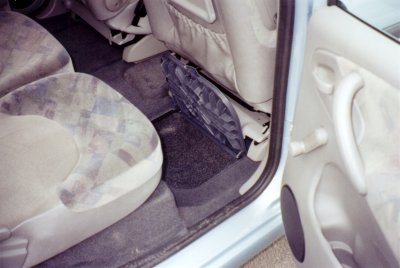
|
|
The
two tone dash has a couple of rubber-covered flat areas that are ideal
for placing a mobile ‘phone or camera but the light colour of the top
of the dash reflects badly in the windscreen and at night, the
illuminated hazard warning switch reflects in the screen.
|
|
The
indicators audible warning is reminiscent of the clacking of a set of
badly fitting dentures but at least this means that you are unlikely to
see a Picasso with its indicators flashing away unnecessarily.
|
|
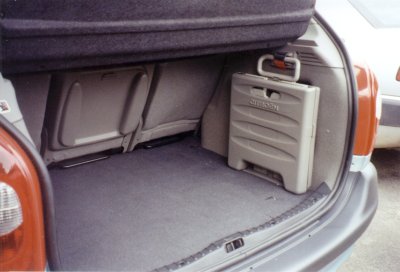
|
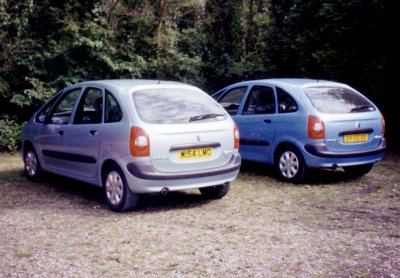
|
|
Then
there is the centre rear seat belt that is routed via a bracket in the
roof and obscures rearward visibility quite noticeably. The bracket in
question is on the offside of the car and has not been moved in the
conversion to RHD.
|
|
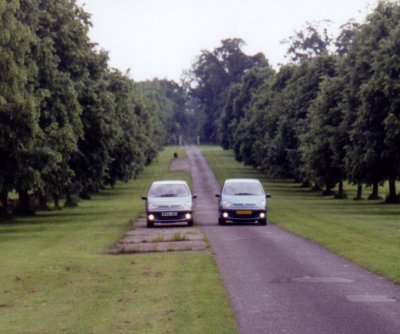
|
But
worst of all are those comfortable looking seats. At the end of the one
hour drive from Slough to Andover, my back was very painful. Now I
suffered a slipped disc several years ago and am particularly prone to
back pain as a result so I assumed it was just me but both Arthur and
Ellen told me they too were suffering from lower back pain and neither
of them have any history of back injuries. Christina too said she
suffered some twinges. On 3rd June, we went to the GS/A & Ami Rally
and before setting out, I ensured that the seat and wheel were
optimally positioned. Within 20 minutes, I was in pain. Clearly the
problem is a total absence of lumbar support. I was in such pain that
on the 4th of June, I could not face driving the Picasso so we went out
in my wide's Xantia and in the Dutch Picasso. I rode in the back of the
Dutch car and discovered that the nearside rear seat was much firmer
than either of the front seats but my head touched the headlining. The
middle and offside seats were just as bad as those in the front and my
head did not touch the headlining. When it came to returning the car to
Slough on 5th June, I 'phoned them and explained that due to back pain
I would prefer that Christina drive the car. Hopefully this will be
referred back to Neuilly since it spoils what is an otherwise excellent
product.
|
|
The trip to the GS/A & Ami Rally
was good fun - a pair of Picassos travelling in convoy attracted a lot
of attention from other road users; there was the driver of a Mégane
Scénic who had to overtake us to get a good look and other Citroën
drivers rubbernecked. At the Rally, the two Picassos were the undoubted
stars of the show.
I covered
just under 300 miles at an average fuel consumption of 36 mpg - a
figure that I would expect to improve on once the engine had loosened
up. A more gentle driving style would help too. The Dutch car managed
some 56 mpg - both of these (real world) figures are impressive.
|
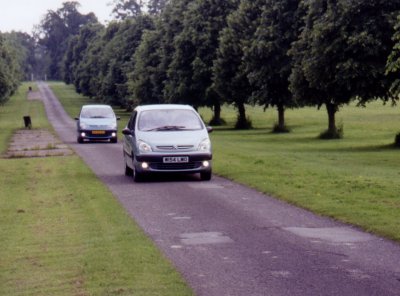
|
|
Arthur's
car developed noise from the nearside front suspension strut and the
driver's seat has worked its way loose. Inevitably this calls into
question the matter of build quality and quality control although I
should point out that his car too is a press fleet car and may very
well have been hammered over the last six months.
|
|
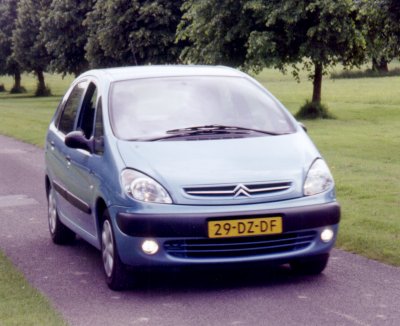
|
To
sum up then, the Picasso presents an extremely strong visual identity,
it is obviously a Citroën. It rides and handles well and both
performance and fuel consumption are good. The interior architecture is
highly adaptable and stowage space is excellent. There are questions
however over build quality and the seats are awful. The quality of some
of the trim is questionable and far from childproof - surprising since
market research shows that buyers of compact MPVs are typically (75%)
male whilst six out of 10 purchasers are aged between 35-54 years and
have children. Clearly the car is built down to a very competitive
price.
|
|
With
117 bhp available, the 1.8i SX at GBP 14,625 is more powerful than the
GBP 75 more expensive Scénic which has only 110 bhp. The Vauxhall/Opel
Zafira offers seven seats, 115 bhp and costs a staggering GB 1625 more.
The Fiat Multipla costs GBP 455 more and offers 115 bhp. Standard
equipment on the Picasso includes passenger and lateral airbags which
are options on the competitors (although a passenger airbag is standard
on the Scénic) and the Citroën is the only one in which the passenger
airbags may be deactivated - essential if you have a baby in a
rear-facing baby seat on the front seat.
|
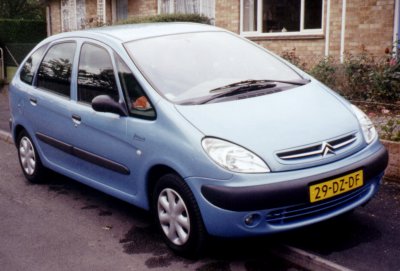 |
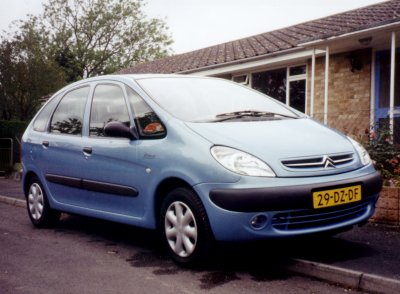 |
Picasso
is the first Citroën to make use of Multiplex wiring which is the key
to many of the neat touches that simply would not be practicable with
conventional electrical systems. For example, the Picasso is the first
car in its class to offer the convenience of ‘guide me home lights’ –
headlamps can be left on for 60 seconds when leaving the car in a
driveway and heading for the front door.
All
this is possible due to a system that simplifies the electrical wiring
and reduces the number of connections by approximately 20% helping to
reduce the total weight of the vehicle. At the same time, the
reliability of the electrical system is further improved by multiplexed
components operating on just two wires – and capable of working
perfectly on just one – thereby overcoming the conventional problem of
loose connections that lead to failure of electronic components. Hidden
in the structure of the vehicle, the Built-in Systems Interface
communicates digitally with six modules via the Vehicle Area Network
that manage functions relating to the instrument cluster, air
conditioning and car stereo.
|
|
Less
technical, but equally impressive is the Xsara Picasso’s three tier low
conductivity windscreen which holds the temperature down thanks to a
middle layer of reflective metal oxide sandwiched between the outer and
inner layers of glass that helps to reduce the interior temperature by
6ºC. This minimises the heating of the dashboard caused by the sun’s
rays, effectively eliminating the "radiator effect" from the fascia and
thereby helping to keep the cabin cool. Solar Plus tinted windows are
fitted in all the doors and the tailgate, again helping to provide
protection from the sun’s rays.
The
Picasso impressed me on a number of scores. I could live with the cheap
trim and the digital dash but not with the seats. The seating question
has been referred to Neuilly and hopefully some changes will be made.
I hope to be able to persuade
Arthur to describe his impressions.
Now, a Picasso with two litre HPi
engine, auto-adaptive gearbox and
decent seats would be a very attractive proposition. An Exclusive
perhaps?
|
 |
© Julian Marsh 2000 |